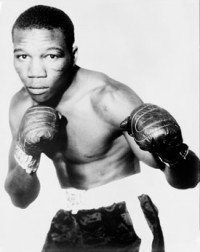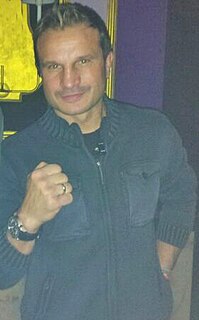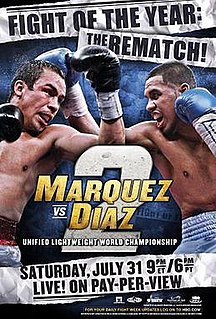
Emile Alphonse Griffith was a professional boxer from the U.S. Virgin Islands who won world titles in three weight divisions. He held the world light middleweight, undisputed welterweight, and middleweight titles. His best-known contest was a 1962 title match with Benny Paret. Griffith won the bout by knockout; Paret never recovered consciousness and died in the hospital 10 days later.

BernardoParet, known as Benny Paret or Benny "Kid" Paret, was a Cuban welterweight boxer who won the World Welterweight Championship twice in the early 1960s.

Edward Patrick "Mickey" Walker was an American professional boxer who held both the world welterweight and world middleweight championships at different points in his career. Born in Elizabeth, New Jersey, he was also an avid golfer and would later be recognized as a renowned artist. Walker is widely considered one of the greatest fighters ever, with ESPN ranking him 17th on their list of the 50 Greatest Boxers of All-Time and boxing historian Bert Sugar placing him 11th in his Top 100 Fighters catalogue. Statistical website BoxRec rates Walker as the 6th best middleweight ever, while The Ring Magazine founder Nat Fleischer placed him at No. 4. The International Boxing Research Organization ranked Walker as the No. 4 middleweight and the No. 16 pound-for-pound fighter of all-time. Walker was inducted into the Ring magazine Hall of Fame in 1957 and the International Boxing Hall of Fame as a first-class member in 1990.

Giovanni "Nino" Benvenuti is an Italian former professional boxer and actor. He held world titles in two weight classes, having held the undisputed super-welterweight championship from June 1965 to June 1966 and the undisputed middleweight championship twice, from April to September 1967, and from March 1968 to November 1970. As an amateur welterweight boxer he won the Italian title in 1956–60, the European title in 1957 and 1959, and an Olympic gold medal in 1960, receiving the Val Barker trophy for boxing style. In 1961, having an amateur record of 120-0, he turned professional and won world titles in the light-middleweight division and twice in the middleweight division. Near the end of his boxing career he appeared in two Italian films, Sundance and the Kid (1969) and then in Mark Shoots First (1975).

Boxing in the 1980s was filled with important fights, events and personalities that shaped the sport. Boxing in the 1980s was shaped by many different situations, such as the continuous corporate battles between the different world sanctioning organizations, the void left by Muhammad Ali as the sport's ambassador and consequent search for a new boxing hero, the continuous presence of Don King as the sport's most famous promoter, the surge of rival promoters as Bob Arum, Butch Lewis and Murad Muhammad, and major rule changes. In 1986, Mike Tyson emerged as a fresh new face in the heavyweight division, which had seen a decline in champion quality level after Ali's retirement and, later on, after longtime WBC ruler Larry Holmes' prime. In addition, the IBF and WBO began operating.
During the 1970s, boxing was characterized by dominating champions and history-making rivalries. The decade had many superstars, who also had fierce rivals. Alexis Argüello, for example, who won the world Featherweight and Jr. Lightweight titles in the '70s, had to overcome Alfredo Escalera twice before the decade was over.
During the 1950s, a couple of relatively new developments changed the world: World War II had only been over for five years when the 1950s began, and television was beginning to make a major impact internationally. In boxing, changes connected to these developments could be seen too, as boxers who fought at the 1940s conflict returned to their homes and many of them were back in the ring. Television producers were in love with sports, which provided the viewer with an opportunity to observe sporting events live, and boxing was not the exception to the rule; many television networks began to feature fights live during the weekends, and the Gillette Friday Night Fights proved to be one of the most popular boxing television series in American history.
Boxing in the 1940s in many ways reflected worldwide events that affected other endeavors as well.

The sport of Boxing in the 1930s was affected by one of the biggest economic struggles in the history of the United States: the depression era. Because of the suffering American economy, many boxers were offered lower amounts of money causing them to only box for passion. When the decade began, the world heavy weight title belonged to no one. The sport of boxing suffered because of the lack of money to pay the boxers.
Boxing in the 1920s was an exceptionally popular international sport. Many fights during this era, some 20 years away or so from the television era, were social events with many thousands in attendance, both men and women.
Ángel Espada is a Puerto Rican former professional boxer. He was the WBA's world Welterweight champion in 1975-76. A music lover, Espada also organized, during the late 1970s, a salsa orchestra.

Luis Manuel Rodríguez was a Cuban professional boxer. Known as "El Feo", he began his career in pre-Castro Havana. In Cuba, he twice defeated the ill-fated future welterweight champion Benny Paret. He held the WBA, WBC, and lineal welterweight titles in 1963, and challenged once for the WBA, and WBC middleweight titles in 1969.

Francisco Javier Castillejo Rodríguez, commonly known as Javier Castillejo, is a Spanish former professional boxer who competed from 1988 to 2009. He held multiple world championships in two weight classes, including the WBC and lineal light-middleweight titles from 1999 to 2001, the WBC light-middleweight title again in 2005, and the WBA middleweight title from 2006 to 2007. At regional level he held the European light-middleweight title twice between 1994 and 1998, and the European Union middleweight title in 2002.
As in the 1980s, the 1990s in boxing's popularity focused on all divisions. When 1980s legends Sugar Ray Leonard, Thomas Hearns, as well as others retired, newer superstars filled the void: Pernell Whitaker, Julio César Chávez, in the early 1990s, Oscar De La Hoya, Félix Trinidad, Roy Jones Jr. and Floyd Mayweather Jr. in the mid to late 1990s.
Boxing in the 2010s includes notable events about boxing which occurred during the decade of the years 2010 to 2019. The decade saw high intensity action in the welterweight division. The match between veterans Floyd Mayweather Jr. and Manny Pacquiao broke PPV records. The broadcast of the fight in the Philippines was watched by nearly half the country's households. Mayweather retired at a record 50-0-0 while Pacquiao became the first eight division champion. The middleweight division saw immense action in the later years of the decade. After a draw in 2017, Canelo Alvarez ended Gennady Golovkin's long reign in 2018. The heavyweight division was dominated by Klitschko brothers before Wladimir's loss to Tyson Fury in 2015. Other talents that emerged were Anthony Joshua, Deontay Wilder and undisputed cruiserweight champion Oleksander Usyk.

Juan Manuel Márquez vs. Juan Díaz II, billed as The Rematch, was a boxing lightweight bout for Márquez's WBA (Super), WBO, and The Ring lightweight championship. This fight is a rematch of the 2009 Fight of the Year, where Márquez knocked out Díaz in the 9th round.
Anthony Perez was an American boxing referee and judge of Puerto Rican descent. During his career, he refereed many major boxing fights and participated in a number of boxing related documentaries.
Boxing in the 2020s is a list of notable fights and events in boxing during the decade from the year 2020 to 2029.
Larry Hazzard Sr. is a former amateur boxer, boxing referee, athletic control board commissioner, teacher and actor. He is a member of the International Boxing Hall of Fame, being inducted during 2010. Hazzard has served as Commissioner of the New Jersey State Athletic Control Board since 2014, his second stint as commissioner after serving from 1985 to 2007.








